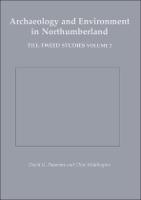Archaeology and Environment in Northumberland
Till-Tweed Studies Volume 2
Author(s)
Passmore, D. G.
Waddington, Clive
Gates, Tim
Marshall, Peter
Collection
Knowledge Unlatched (KU)Language
EnglishAbstract
Eventful, influential and absorbing, the early history of Northumberland is a fascinating story that has rarely been brought together under one cover. In this authoritative historical account, the authors bring to bear a huge quantity of old and new data and craft it into an in-depth synthesis. The authors deliver this history in chronological order from a perspective that places human activity and environment at its core. The narrative extends from the Palaeolithic through to, and including, the Anglo-Saxon period. This enormous sweep of history is supported by a robust radiocarbon chronology, with all available dates for the region brought together and calibrated against the most recent calibration curves for the first time. The geographic focus of the volume is North Northumberland but the narrative frequently extends to cover the whole county and occasionally further afield into neighbouring areas so as to deal with key topics at an appropriate geographic scale and to take account of important information from nearby areas. This second volume in the Till-Tweed monograph series follows on from the first volume, Managing Archaeological Landscapes in Northumberland , which provided a considerable quantity of new field data, in addition to presenting a landscape management methodology based around the "landform element" approach.


 Download
Download